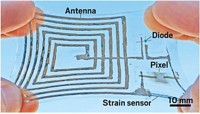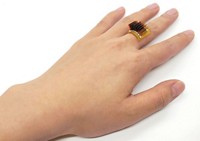Advertisement
Grab your lab coat. Let's get started
Welcome!
Welcome!
Create an account below to get 6 C&EN articles per month, receive newsletters and more - all free.
It seems this is your first time logging in online. Please enter the following information to continue.
As an ACS member you automatically get access to this site. All we need is few more details to create your reading experience.
Not you? Sign in with a different account.
Not you? Sign in with a different account.
ERROR 1
ERROR 1
ERROR 2
ERROR 2
ERROR 2
ERROR 2
ERROR 2
Password and Confirm password must match.
If you have an ACS member number, please enter it here so we can link this account to your membership. (optional)
ERROR 2
ACS values your privacy. By submitting your information, you are gaining access to C&EN and subscribing to our weekly newsletter. We use the information you provide to make your reading experience better, and we will never sell your data to third party members.
Materials
This Hydrogel Can Sing
Materials Science: Stretchy, vibrating devices might serve as implantable sensors
by Lauren K. Wolf
September 2, 2013
| A version of this story appeared in
Volume 91, Issue 35
The possibility of implantable electronic sensors to bolster functioning of a person’s brain, heart, or skin depends on scientists’ success in developing flexible electronic circuits that are biocompatible. But all the bendy electronics made so far rely on components such as copper or graphene to conduct electrons across their surfaces, says Zhigang Suo, a professor of mechanics and materials at Harvard University. And those materials, he adds, might not interact well with the human body.
Suo and colleagues, including Harvard chemistry professor George M. Whitesides, have addressed this shortcoming by making an inert gel-based device that conducts electrical charge not via electrons but via ions that normally help signal a person’s heart to beat or nerves to fire (Science 2013, DOI: 10.1126/science.1240228). The team’s ionic conductor is also transparent to light, a plus for possible optical applications.
To make their device, Suo, Whitesides, and coworkers began with a 1-mm-thick piece of double-sided sticky tape. They sandwiched this insulating sheet between two thin, salt-filled layers of a polyacrylamide hydrogel.
When the team applies a voltage across the see-through sandwich with electrodes placed along its edges, sodium and chloride ions in the hydrogels move rapidly, generating an electrostatic force that causes the inner insulator to flex like a muscle, nearly doubling its original dimensions.

In the past, scientists thought ionic conductors weren’t suitable for use in electronics because their relatively bulky ions wouldn’t allow them to respond fast enough to applied voltages. Electrons, on the other hand, are the darlings of conduction because they are small and move rapidly across metals and other materials. Although it still isn’t as conductive as a metal, the Harvard team’s stretchy device can operate at such high frequencies of applied voltage that it generates sound.
According to Suo, one of the postdocs on the Harvard team, Christoph Keplinger, is an audio system enthusiast, so he had the idea to demonstrate the ionic conductor’s ability to handle high frequencies—in the 20- to 20,000-Hz range, which people can hear—by turning it into a loudspeaker. When the researchers took the audio output from a soundtrack played on a laptop, ran it through an amplifier, and fed it to the material, it played the song.
John A. Rogers, a materials scientist at the University of Illinois, Urbana-Champaign, says this “clever” technology “can be thought of as a transparent artificial muscle, with potential for use in things like noise-canceling windows and reconfigurable optics.”
Suo hopes that once engineers see the simplicity of the hydrogel sandwich they’ll find new uses for old electronic devices. By replacing some components with ionic conductors, he says, “you might sacrifice some conductivity, but you’ll gain transparency, stretchability, and possibly even biocompatibility.”





Join the conversation
Contact the reporter
Submit a Letter to the Editor for publication
Engage with us on Twitter